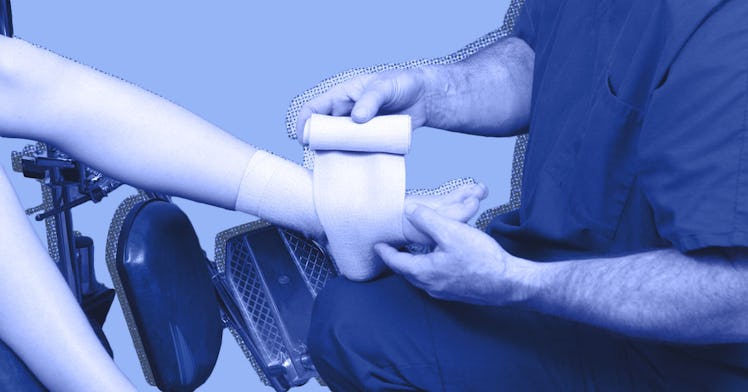Your Kid Will Sprain Their Ankle. Here’s What To Do About It
Knowing how to handle a seemingly simple sprained ankle could save your kid from lifelong problems.

Your kid may roll their ankle playing tag in the backyard or at a soccer game. You might even do the same when you infuriatingly step on one of their toys. Spraining one’s ankle is, in many ways, part of moving through life. “When you step on something, it’s a natural response to want to get the weight off of it,” Dr. Lance Silverman, an orthopedic surgeon who specializes in ankle and foot surgery told Fatherly. Occasionally, redistributing your weight means something goes snap.
Ankle sprains are the single most common sports injury. Approximately 25,000 people sprain their ankles daily and half of these occur during an athletic activity. Fatherly spoke to Dr. Silverman about the sprained ankles—how to treat them, how to prevent them, when to take them seriously and how getting it wrong could cause lifelong problems for your junior athlete.
It’s all about the ligaments
About 80 percent of all ankle sprains are inversions, “Where the instep of the foot rolls towards the other foot,” Silverman says. When this happens just right (or, as it were, wrong) ligaments — the tough strings of tissue that connect the foot and ankle bones — tear, resulting in a sprain. Ankle sprains are classified by how seriously the ligament has been torn. Microscopic tears are known as Grade One Sprains, are relatively minor, and can take up to 10 days to heal. Partial tears, lengthening of ligaments, and looseness of the ankle joint all up the injury to Grade Two. Grade Three represents the complete obliteration of the ligament. This last grade can take 60 days to heal without surgery, and is characterized by a sickening “pop” sound. Non-surgical treatments include rest, compression, and ice to reduce swelling, sometimes followed by physical therapy, and the gradual reintroduction of activities that don’t require any ankle rolling.
Doctors did not always believe kids could sprain their ankles
“Classic teaching was that kids did not sprain their ankles because their bones were softer than their ligaments,” Silverman says. But experts now agree that children certainly can and do sprain their ankles, often more seriously because of their softer bones. Sometimes, Silverman says, they rip the ligament right off the bone and take a fractured piece of bone along with it. Adults, on the other hand, tend to sprain ligaments in the center of the ankle, instead of where the ligaments meet the bone.
“A sprain is worse than a fracture”
There is some truth to the saying a sprain is worse than a fracture, Silverman says. “Sometimes the functional limitations of a sprain come back 20 years later.” When this happens, it’s because the ligaments didn’t heal properly, but the effects remained latent because kids can often accommodate weak ankles in their youth. In other words, your kid could sprain their ankle and appear to have healed just fine — until they grow up and start to feel it while playing with their grandkids.
When to seek medical attention
Generally speaking, if two weeks pass after an injury and your kid still cannot put weight on their ankle, it’s time to see a doctor, Silverman says. And if the pain is still present at six weeks, it may be time for an MRI scan. If the pain goes away on its own, he adds, children seldom need medical attention for a sprained ankle. As for whether surgery is warranted, Silverman says the medical community is divided. “There’s some dispute of whether all sprains can heal without surgery,” he says. Silverman notes that, for rare types of sprains such as eversion sprains (where the ankle rolls outwards) or high ankle sprains (which take place about the ankle joint), surgery is often required immediately.
How to prevent it
The best way to avoid ankle sprains at any age is to lead a healthy, active lifestyle, ideally on level ground. But beyond maintaining muscle and bone health to protect your kid’s precious ligaments, Silverman recommends “prehab” exercises — especially for kids who play basketball, soccer, volleyball, and any sports that involve jumping and cutting quickly from side to side. Prehab exercises are warm-up stretches designed to increase a person’s awareness of a specific body part to prevent over-use of that limb. Although there are plenty of Googleable prehab exercises, Silverman recommends consulting with a physical therapist or athletic trainer to help tailor a program that addresses the areas your kid is most likely to injure.
Another way to prevent ankle sprains, especially for new parents, is to keep hazards off the floor as much as possible. “Dark hallways where children were present are dangerous because they never put anything away,” he says.
“It’s like a jungle when you have kids.”